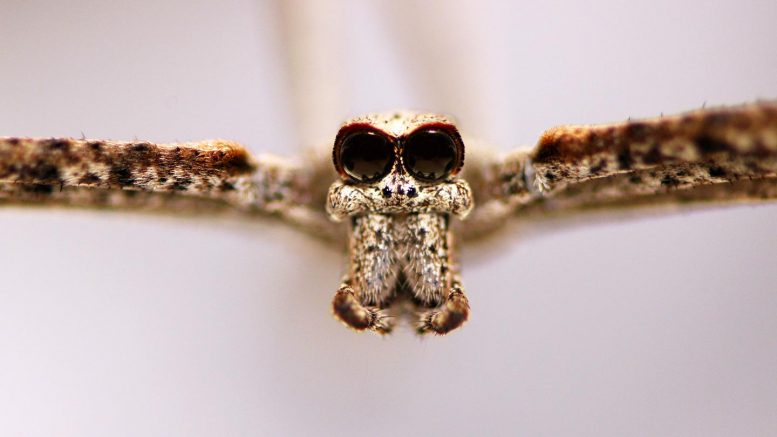
Ogre-faced spiders, named for their massive eyes, hide during the day and hunt by night, dangling from Florida palm fronds and casting silk nets on insects on the ground and in the air. In addition to their incredible night vision, these spiders also can hear their predators and prey, researchers report in the journal Current Biology on October 29, 2020. Having no ears, the spiders use hairs and joint receptors on their legs to pick up sounds from at least 2 meters away. The results suggest that spiders can hear low-frequency sounds from insect prey as well as higher frequency sounds from bird predators.
“I think many spiders can actually hear, but everybody takes it for granted that spiders have a sticky web to catch prey, so they’re only good at detecting close vibrations,” says senior author Ron Hoy, professor of neurobiology and behavior at Cornell University. “Vibration detection works for sensing shaking of the web or ground, but detecting those airborne disturbances at a distance is the province of hearing, which is what we do and what spiders do too, but they do it with specialized receptors, not eardrums.”
This high-speed video shows the backwards strike of an ogre-faced spider. Credit: Sam Whitehead
Instead of passively waiting for prey to fall into a web and get stuck, ogre-faced spiders use their webs as a weapon. After spending the daylight hours completely still, blending in with the surrounding palmetto fronds, they emerge at night to dangle close to the ground and cast their webs like a net on unwary insects. While they use their keen night vision to catch prey on the ground, they can also catch insects in the air by performing an elaborately choreographed backwards strike, which does not seem to rely on vision.
“In a previous study, I actually put dental silicone over their eyes so they couldn’t see,” says first author Jay Stafstrom, a postdoctoral researcher in the Hoy Lab. “And I found that when I put them back out into nature, they couldn’t catch prey from off the ground, but they could still catch insects from out of the air. So I was pretty sure these spiders were using a different sensory system to hunt flying insects.”

While that study hinted that the spiders might be able to hear, this one showed just how well they can do it. By observing the spiders’ reactions to different tones and measuring their neural response with electrodes placed in the spiders’ brains and legs, the team determined that the spiders could hear sounds of up to 10 kHz in frequency, far higher than the sounds of a walking or flying insect.
“When I played low tone frequencies, even from a distance, they would strike like they were hunting an insect, which they don’t do for higher frequencies,” says Stafstrom. “And the fact that we were able to do that from a distance, knowing we’re not getting up close and causing them to vibrate. That was key to knowing they can really hear.”
Hearing these higher frequencies may not be helpful for hunting, but it may help them stay alert when hiding from their own predators.
“If you give an animal a threatening stimulus, we all know about the fight or flight response. Invertebrates have that too, but the other ‘f’ is ‘freeze.’ That’s what these spiders do,” says Hoy. “They’re in a cryptic posture. Their nervous system is in a sleep state. But as soon as they pick up any kind of salient stimulus, boom, that turns on the neuromuscular system. It’s a selective attention system.”
While these results make it clear that the spiders can detect sounds well, the researchers are next interested in testing their directional hearing — whether they can tell where sounds are coming from. If they can also hear directionally, this might help further explain their acrobatic hunting style.
“What I found really amazing is that to cast their net at flying bugs they have to do a half backflip and spread their web at the same time, so they’re essentially playing centerfield,” says Hoy. “Directional hearing is a big deal in any animal, but I think there are really going to be some interesting surprises from this spider.”
Reference: “Ogre-Faced, Net-Casting Spiders Use Auditory Cues to Detect Airborne Prey” by Jay A. Stafstrom, Gil Menda, Eyal I. Nitzany, Eileen A. Hebets and Ronald R. Hoy, 29 October 2020, Current Biology.
DOI: 10.1016/j.cub.2020.09.048
This work was supported by the National Science Foundation
1 Comment
This is nothing new. Net casting spiders have been known to science for decades. Also, species that can perceive airborne pressure waves(hear) without ears are not new.